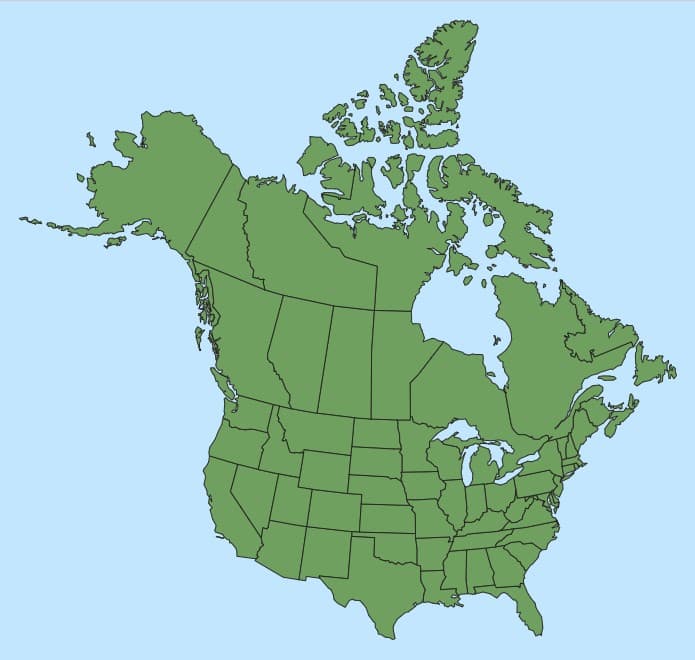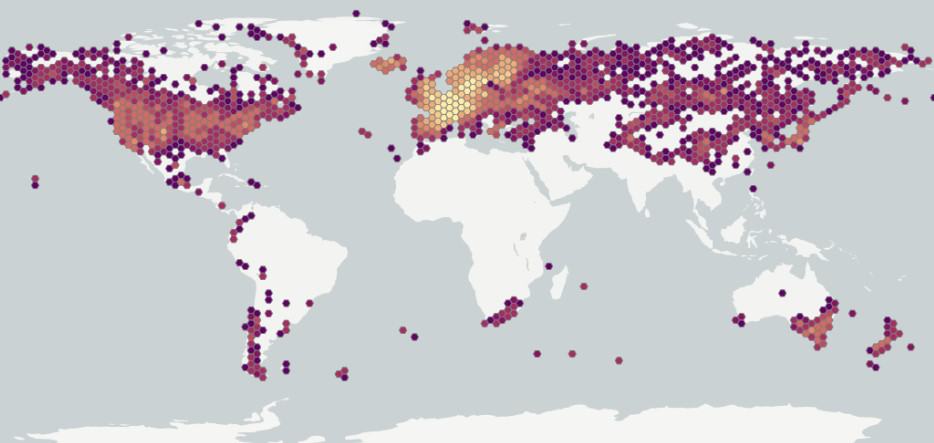Poa pratensis
Explore More :
Explore plus :
Overview
Aperçu
Regulation :
Remarques Réglementation:
Regulation Notes:
Distribution :
Répartition :
Poa pratensis is native to temperate and arctic Europe, Asia and parts of North Africa but has since been introduced and become naturalized widely around the world including in parts of North America, South America, Southern Africa, Asia, Australasia, Atlantic and Pacific islands as well as in Antarctica (Barkworth et al. 2007, CABI 2022). Although P. pratensis is generally considered native to Eurasia, some botanists believe undisturbed high mountain meadow populations in western North America (DiTomasso and Healy 2007) and certain arctic and subarctic subspecies to be native to North America (Barkworth et al. 2007).
Habitat and Crop Association :
Habitat et Cultures Associées :
Poa pratensis invades moist to dry meadows, open forests, shrublands, disturbed areas, grasslands, rangelands, pastures, riparian habitat and freshwater wetlands (Douglas et al. 2001; Weber 2017; PIER 2011).
Poa pratensis is a common weed in pastures and has been reported to impact Triticum aestivum (common wheat), Hordeum vulgare (barley) and Anemone patens (eastern pasqueflower) (Weber 2017; CABI 2022).
Economic Use, cultivation area, and Weed Association :
Utilisation économique, zone de culture et association de mauvaises herbes :
Primarily cultivated in temperate regions as a cool-season grass, Poa pratensis is used extensively in home lawns and parks as the plant forms dense green sod (Bush 2002). It is also excellent for turf in ball parks, golf courses, picnic grounds and campgrounds, and is grown as forage and for erosion control (Bush 2002).
Duration of Life Cycle :
Durée du cycle vital:
Perennial
Dispersal Unit Type :
Type d’unité de dispersion :
Spikelet, floret, caryopsis
General Information
RENSEIGNEMENTS GÉNÉRAUX
Poa pratensis is a highly polymorphic species that reproduces sexually and apomitically (produces seeds without the fusion of male and female gametes) (Barkworth et al. 2007). It propagates mainly via seed and a single P. pratensis plant can produce up to 200 seeds per panicle per year (CAL-IPC 2022).
Poa pratensis hybridizes naturally with P. alpina, P. arctica, P. palustris, P. secunda, and P. wheeleri, and artificial hybrids have also been developed with other Poa species (Barkworth et al. 2007; DiTomaso and Healy 2007). As an important sod-forming cool season grass, many cultivated varieties of P. pratensis have been developed by the seed industry for use as lawn, recreational turf, pasture, and erosion control (Alderson and Sharp 1995). In commercial seed markets, Poa pratensis is sometimes purposefully mixed with P. trivialis (rough bluegrass) or P. compressa (Canada bluegrass).
Poa pratensis is considered invasive in cases where it has escaped human cultivation as it forms dense stands that can crowd out native vegetation (PIER 2011). Litter produced by P. pratensis forms thick mats of ‘slicks’ on the soil surface which inhibit seedling establishment (CABI 2022). Control of P. pratensis can be difficult due to vegetative growth by tillers and rhizomes which are stimulated to grow after mowing (Weber 2017).
.Identification
Identification
-
Spikelet
Size
- Spikelet length: 3 – 7 (9) mm (Douglas et al. 2001; Barkworth et al. 2007; eFloras 2022).
Spikelet size from literature:
- Spikelet length: 4 – 7 mm (Douglas et al. 2001).
- Spikelet length: 3.5 – 6 (7) mm (Barkworth et al. 2007).
- Spikelet length: 3 – 7 (9) mm (eFloras 2022).
Shape
- Spikelet shape oblong-oval, laterally compressed.
Surface Texture
- Spikelet surface texture papery with short stiff hairs.
Colour
- Spikelet colour light yellowish or greenish brown.
Other Features
Spikelet composition
- Multiple floret spikelet with 2 – 5 similar looking florets, with florets near spikelet tip usually sterile and slightly smaller in size.
Glumes
- Glumes broadly teardrop shaped and keeled.
- Glumes thin and papery.
- Glume keels with short stiff hairs.
- Lower glume length 1.5 – 4 (4.5) mm, 1 – 3 nerved (Barkworth et al. 2007).
- Upper glume length 2 – 4.5 (5) mm, 3 (5) veined, equal to or shorter than the lowest lemma (Barkworth et al. 2007; eFloras 2022).
Disarticulation
- Spikelet disarticulation generally occurs above glumes and between florets at rachilla nodes, although intact spikelets can be occasionally found in commercial seed lots.
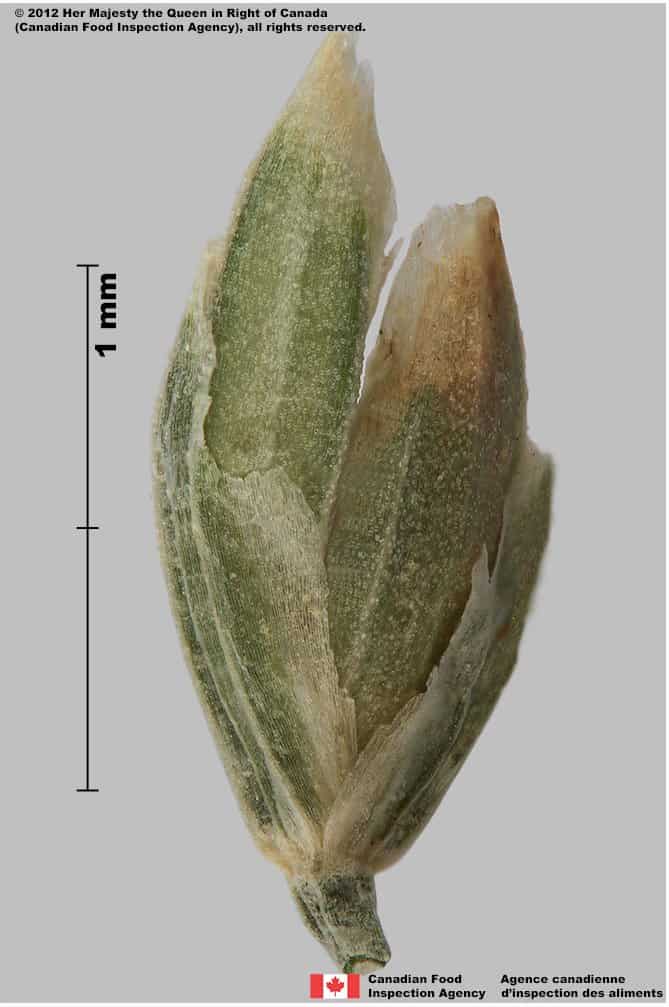
Kentucky bluegrass (Poa pratensis) spikelet

-
Floret
Size
- Floret length*: 1.7 – 3.9 mm (average 2.8 mm); width*: 0.5 – 1.1 mm (average 0.7mm); thickness*: 0.5 – 1.0 mm (average 0.8 mm).
- Rachilla length*: 0.1 – 1.0 mm (average 0.5 mm).
*Measurement notes: minimum and maximum size based 40 florets in normal range of this species using image measurement protocol (ISMA 2020). Length equals longest measurement of floret, width equals greatest measurement of floret in palea view, thickness equals greatest measurement of floret in lateral view. CDA-S-24966, CDA-S-24981, CDA-S-25000; CDA-S-25031.
Size measurements from literature:
- Lemma length: 2 – 4.3 (6) mm (Douglas et al. 2001).
- Floret length: 2.4 – 3.2 mm; width: 0.6 – 0.7 mm (Bojňanský and Fargašová 2007).
- Lemma length: 2 – 4.3 (6) mm (Barkworth et al. 2007).
- Lemma length: 2.5 – 4 (5) mm; rachilla length: 0.5 – 1 (1.2) mm (eFloras 2022).
Shape
- Floret shape: oblong-teardrop shaped (oblong-lanceolate), laterally compressed, keeled along back of lemma.
Surface Texture
- Lemma and palea papery.
Colour
- Floret colour light to dark yellowish-brown coloured, usually darker near the base, may be green or purple tinged.
Other Features
Lemma
- Lemma 5-nerved.
- Lower two-thirds of keel and marginal veins with long soft hairs.
- Lateral nerves prominent and usually without hairs.
- Area between veins without hairs, lower portion smooth or bumpy, upper portion smooth or with sparse short stiff hairs (Barkworth et al. 2007).
- Lemma apex broadly tapered to a point; sides folded slightly inward near tip.
- Lemma loosely enclosing caryopsis.
Note: in commercial seed lots the hairs and some lemma tissue may be removed during the milling processing.
Awn
- Lemma without awn.
Callus
- Callus blunt, with long, silky, web-like hairs (may be missing in milled seed).
Rachilla
- Rachilla about one-fifth the length of the floret (shorter in basal florets and longer in distal florets), without hairs, may be slightly bumpy.
Palea
- Palea slightly shorter than lemma.
- Palea slightly creased inward longitudinally.
- Palea keels two.
- Hairs on palea keels (palea teeth) coarse (i.e., broad base and narrowing to a point) and widely spaced, except near tip of palea.
- Palea tip slightly notched.
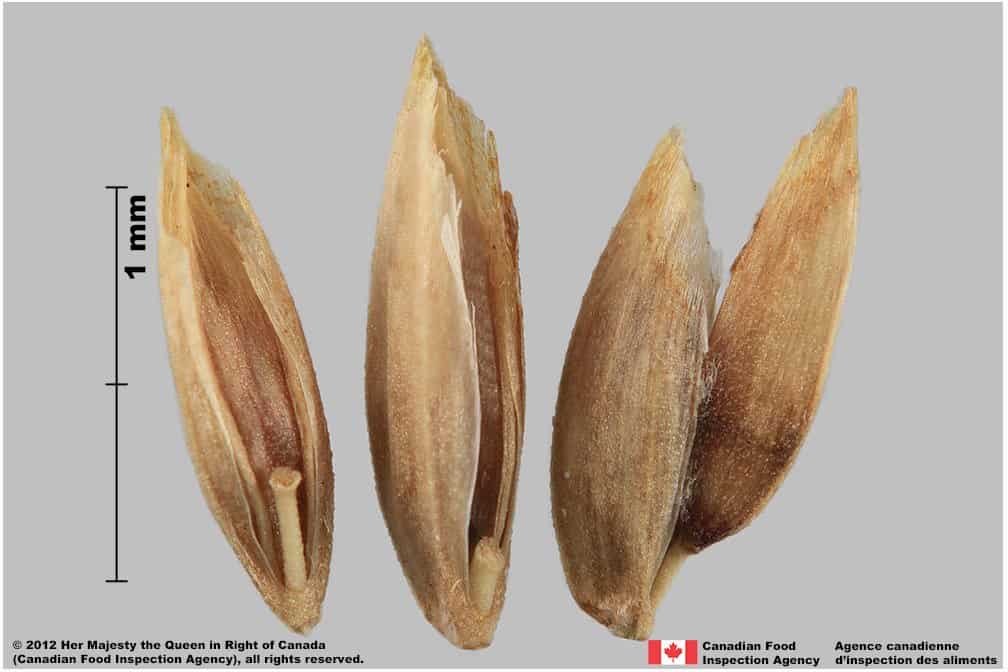
Kentucky bluegrass (Poa pratensis) florets

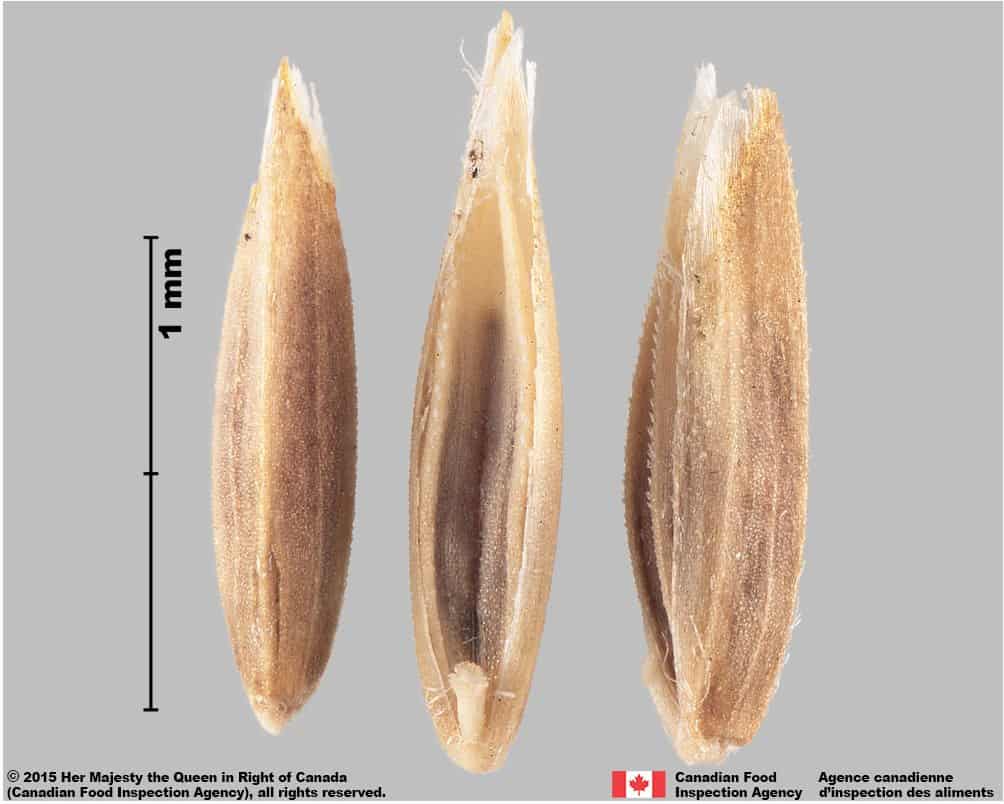
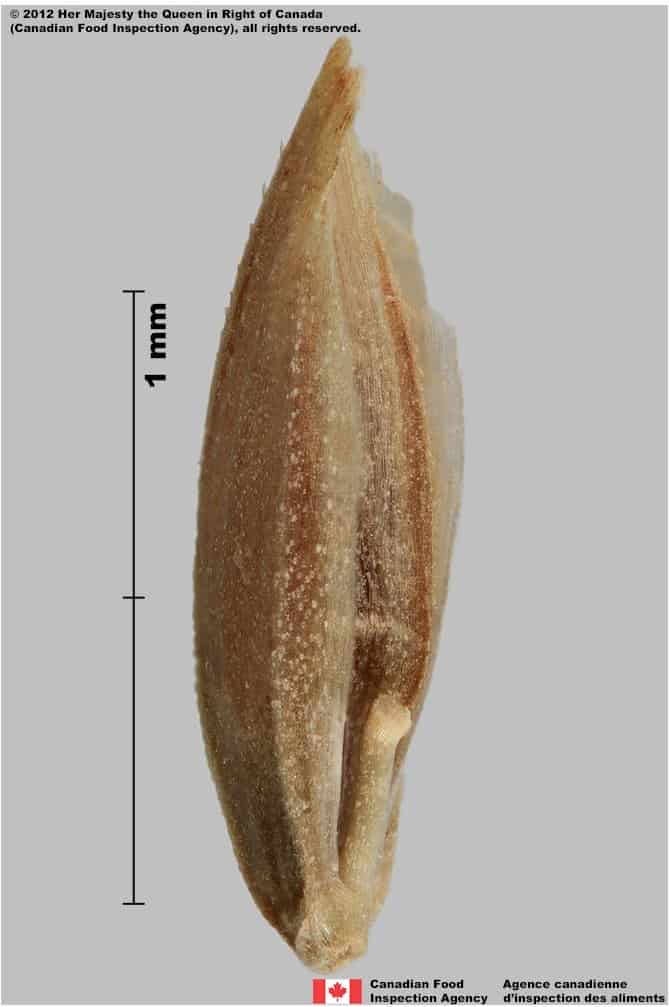
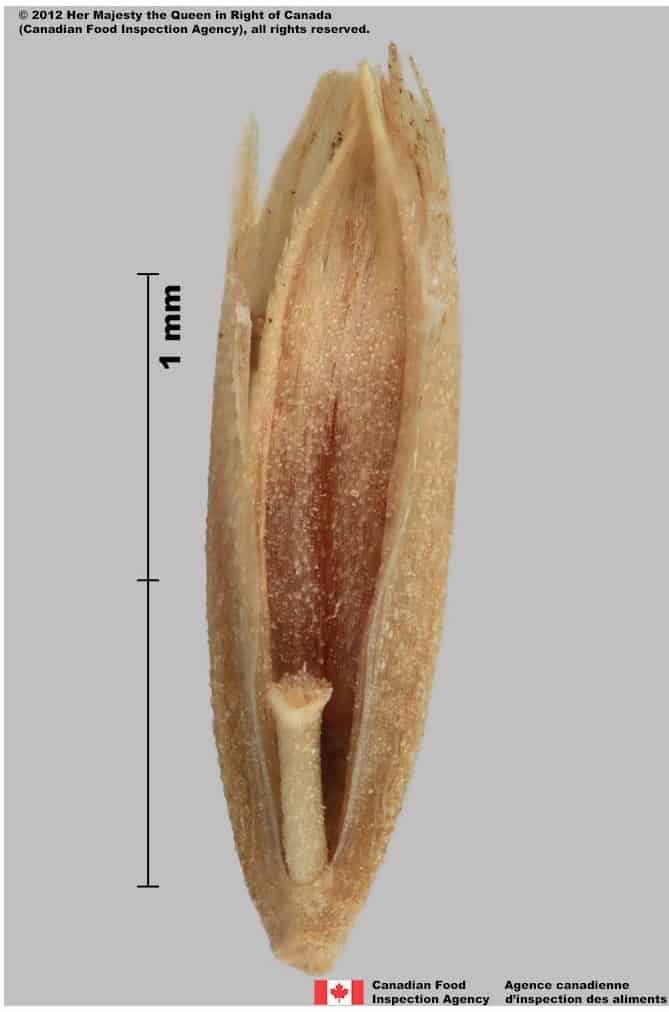
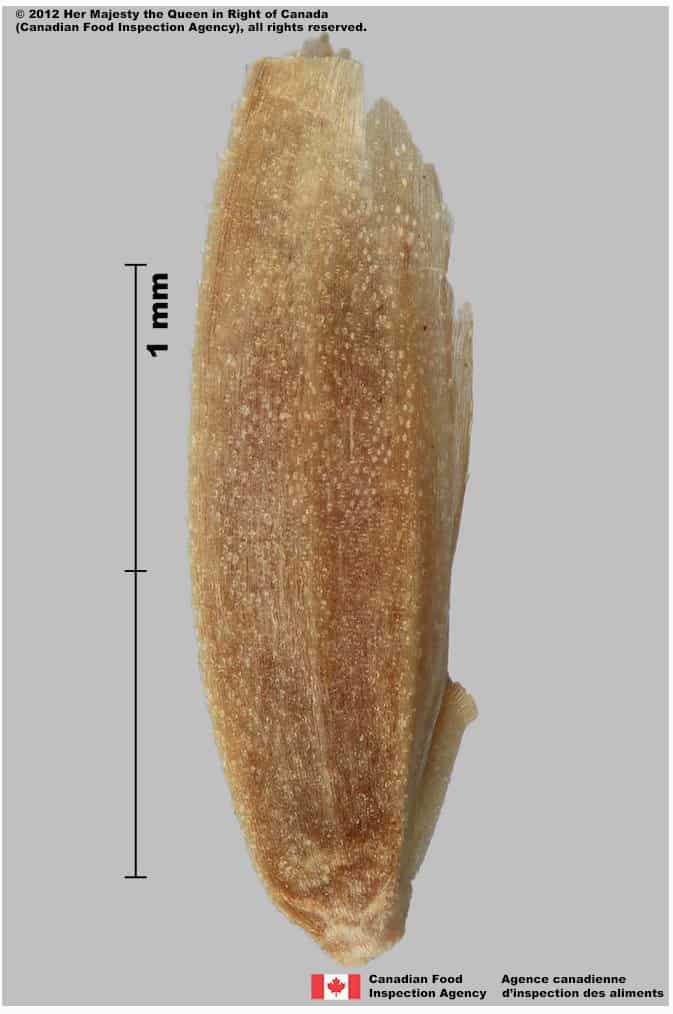
-
Caryopsis
Size
- Caryopsis length*: 1.5 – 1.9 mm (average 1.8 mm); width*: 0.6 mm (average 0.6 mm); thickness*: 0.6 mm (average 0.6 mm).
- Hilum length*: 0.13 – 0.18 mm (average 0.15 mm).
*Measurement notes: minimum and maximum size based 3 caryopses in normal range of this species using image measurement protocol (ISMA 2020). Length equals longest measurement of caryopsis, width equals greatest measurement of caryopsis in embryo view, thickness equals greatest measurement of caryopsis in lateral view. CDA-S-24966.
Caryopsis measurements from literature:
- Caryopsis length: 1.5 – 2 mm; width: 0.5 – 0.6 mm (Bojňanský and Fargašová 2007).
Shape
- Caryopsis spindle-shaped, slightly compressed laterally, round to triangular in cross-section.
Surface Texture
- Caryopsis surface smooth to faintly striate, slightly shiny.
Colour
- Caryopsis reddish-brown coloured.
Other Features
- Hilum a small round spot located near base of caryopsis on the side opposite the embryo.
-
Embryo
Size
- Embryo length*: 0.3 – 0.5 mm (average 0.4 mm).
- Embryo about one-fifth the length of caryopsis.
*Measurement notes: minimum and maximum size based 3 embryos in normal range of this species using image measurement protocol (ISMA 2020). CDA-S-24966.
Shape
- Embryo oval.
Endosperm
- Endosperm solid (Terrell 1971).
Other Features
- Embryo lateral (Martin 1946).
Identification Tips
CONSEILS POUR L’IDENTIFICATION
Several characters are key to separating Poa pratensis from other species of Poa. These include:
- Lemma keeled, keel straight to slightly curved, lemma tip folded inward.
- Lateral nerves on lemma prominent, usually without hairs.
- Lower two-thirds of lemma keel and marginal nerves with long soft hairs (may be missing on milled florets).
- Hairs on palea keels (palea teeth) short, coarse, and widely spaced but not extending to palea tip.
- Caryopsis loosely enclosed by the lemma.
- Long cobweb-like hairs on the callus (may be missing on milled florets).

Kentucky bluegrass (Poa pratensis) floret, palea view





Additional Botany Information
AUTRES RENSEIGNEMENTS BOTANIQUES
Flowers/Inflorescence
- Panicle 2 – 15 (20) cm, narrowly egg-shaped to pyramid shaped, loosely contracted to open, with (25) 30 – 100 or more spikelets and (1) 2 – 7 (9) branches per node (Douglas et al. 2001; Barkworth et al. 2007).
Vegetative Features
- Plant densely or loosely tufted, spreading via rhizomes.
- Stems 5 – 70 (100) cm tall, erect or bases flat on ground and ends upright (Douglas et al. 2001; Barkworth et al. 2007).
Similar Species
ESPÈCES SEMBLABLES
Similar species are based on a study of seed morphology of various species, and those with similar dispersal units are identified. The study is limited by physical specimen and literature availability at the time of examination, and possibly impacted by the subjectivity of the authors based on their knowledge and experience. Providing similar species information for seed identification is to make users aware of similarities that could possibly result in misidentification.
Poa annua, P. compressa, and P. trivialis can be found as contaminants in seed lots of P. pratensis or other types of lawn, turf, and pasture grass seed lots. Key diagnostic features to separate florets these four species are included in the comparison table:
Comparison table of morphological characters of unmilled Poa florets.
| P. pratensis | P. compressa | P. trivialis | P. annua | |
| Floret shape | Lemma keeled, keel straight to slightly curved.
Lemma tip folded inward. |
Lemma and palea usually flared open at tip. | Lemma sharply keeled; keel curved.
Lemma tip folded inward. |
In lateral view the palea appears like a bulging belly.
Lemma tip folded inward or flared out. |
| Lemma | Papery | Papery | Papery, appearing oil soaked. | Papery with membranous margins. |
| Lemma nerves and keel | Lateral nerves prominent, usually without hairs.
Lower two-thirds of keel and marginal nerves with long soft hairs.
|
Lateral nerves obscure or lacking.
Lower two-thirds of keel and marginal nerves with long soft hairs.
|
Marginal and lateral nerves and keel prominent, without hairs. | Lateral nerves prominent. Keel, marginal and lateral nerves with long silky hairs in the lower half. |
| Palea keel hairs (palea teeth) | Short, coarse, wide-spaced, and not extending to tip of palea | Short, fine, close-spaced, and extending to tip of palea | Short, fine, close-spaced, and extending to tip of palea | Long, densely spaced, and not extending to tip of palea |
| Caryopsis |
Caryopsis spindle shaped, loosely enclosed by lemma and palea. |
Caryopsis spindle shaped, loosely enclosed by lemma and palea. | Caryopsis spindle shaped, tightly enclosed by lemma and palea. | Embryo pinched and beak-like.
Surface with fine-net-like texture. Caryopsis loosely enclosed by lemma and palea. |
| Callus hairs | Long & web-like | Short & web-like | Long & web-like | None |
Click to select species
Cliquez pour sélectionner les espèces
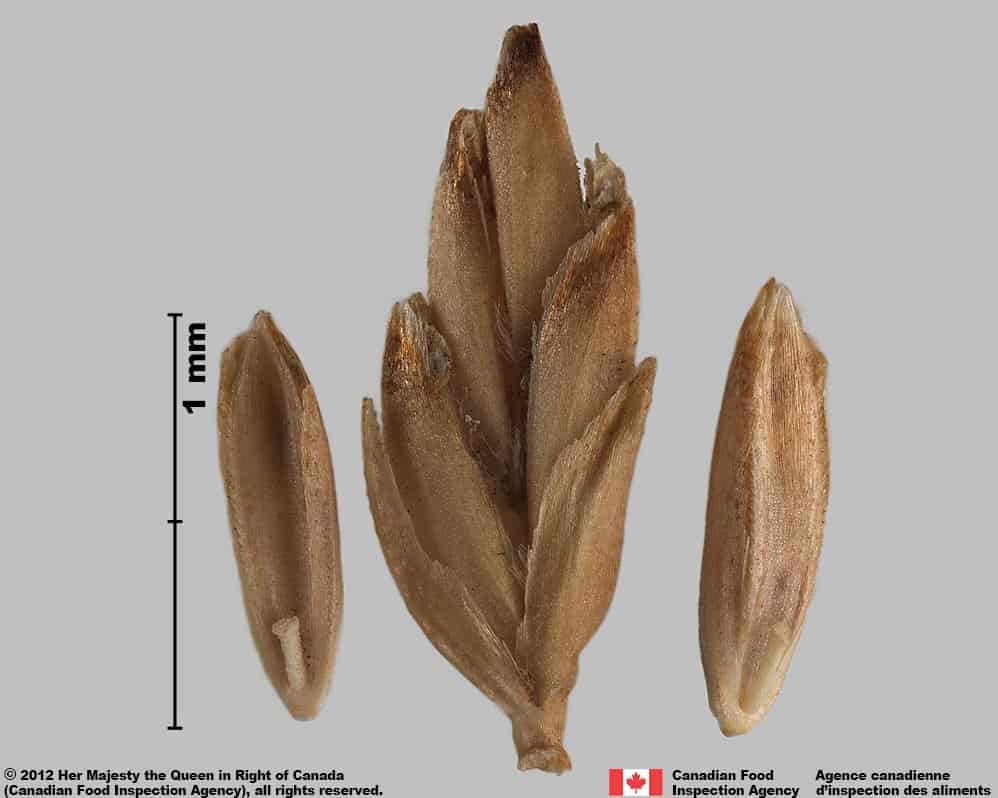
Poa compressa
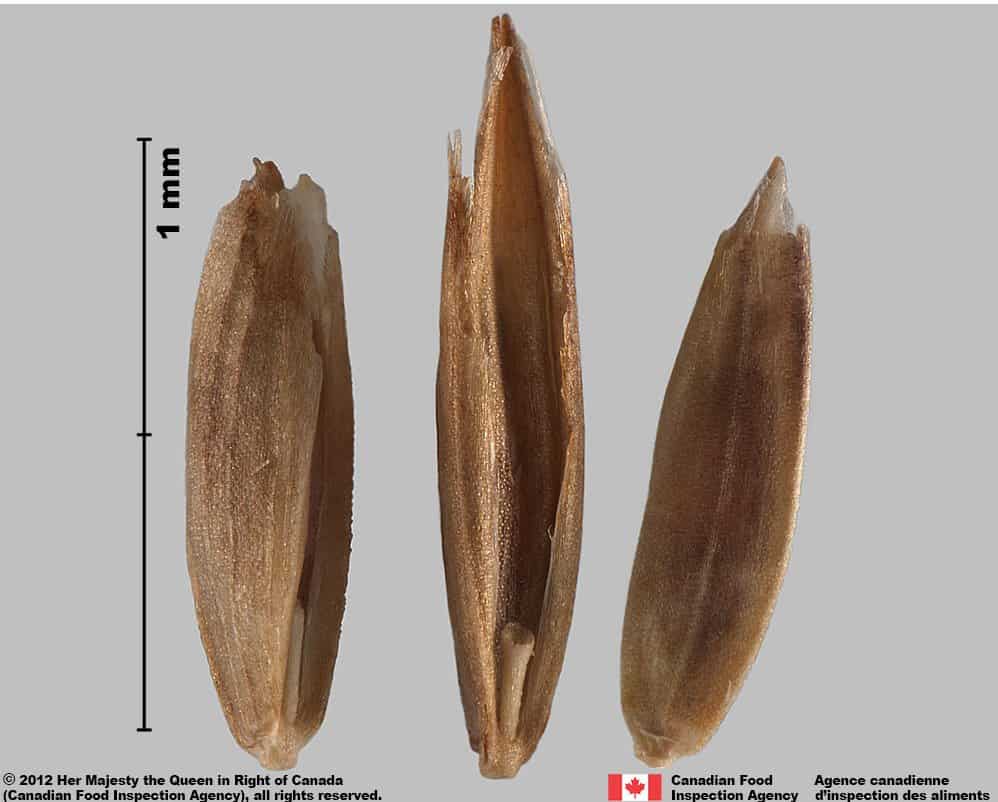
Poa trivialis
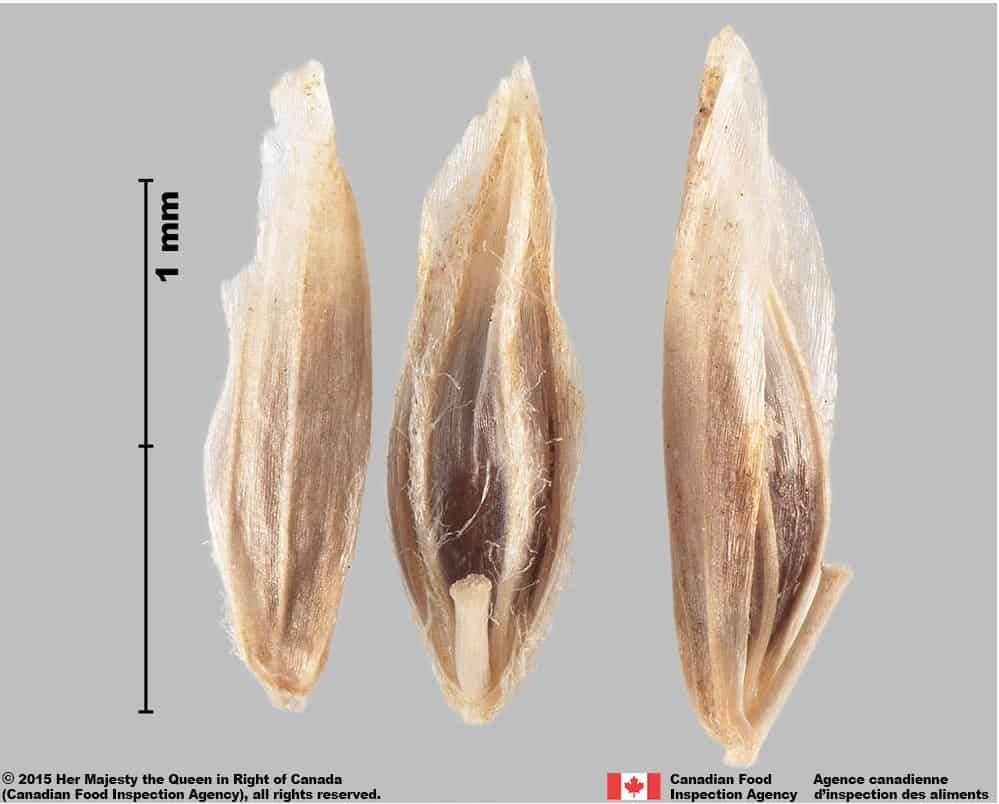
Poa annua
Comparison Window
Fenêtre de comparaison
MAIN SPECIES
ESPÈCES PRINCIPALES
Poa pratensis

Poa pratensis
Poaceae
Kentucky bluegrass (Poa pratensis) florets
MAIN SPECIES
ESPÈCES PRINCIPALES
Poa pratensis

Poa pratensis
Poaceae
Kentucky bluegrass (Poa pratensis) florets
MAIN SPECIES
ESPÈCES PRINCIPALES
Poa pratensis

Poa pratensis
Poaceae
Kentucky bluegrass (Poa pratensis) spikelet
MAIN SPECIES
ESPÈCES PRINCIPALES
Poa pratensis

Poa pratensis
Poaceae
Kentucky bluegrass (Poa pratensis) floret, palea view
MAIN SPECIES
ESPÈCES PRINCIPALES
Poa pratensis

Poa pratensis
Poaceae
Kentucky bluegrass (Poa pratensis) floret, palea view
MAIN SPECIES
ESPÈCES PRINCIPALES
Poa pratensis

Poa pratensis
Poaceae
Kentucky bluegrass (Poa pratensis) floret, side view
MAIN SPECIES
ESPÈCES PRINCIPALES
Poa pratensis
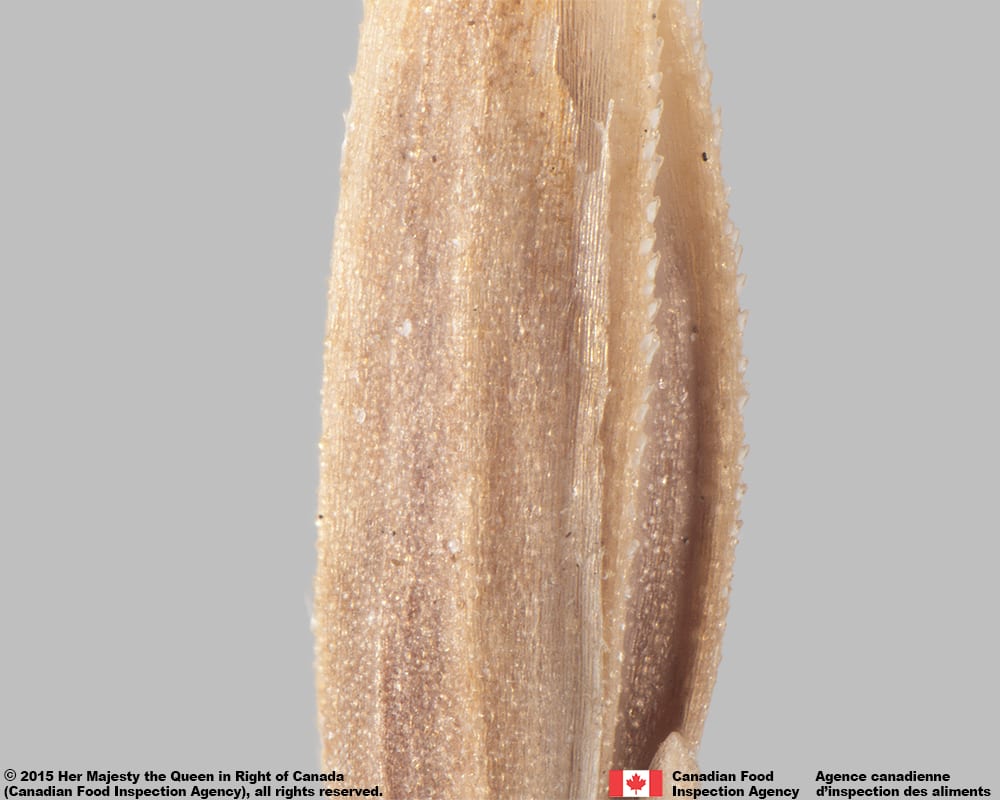
Poa pratensis
Poaceae
Kentucky bluegrass (Poa pratensis) floret, side view
SIMILAR SPECIES
ESPÈCES SEMBLABLES
Poa compressa

Poa compressa
Poaceae
Canada bluegrass (Poa compressa) spikelet and florets
SIMILAR SPECIES
ESPÈCES SEMBLABLES
Poa compressa
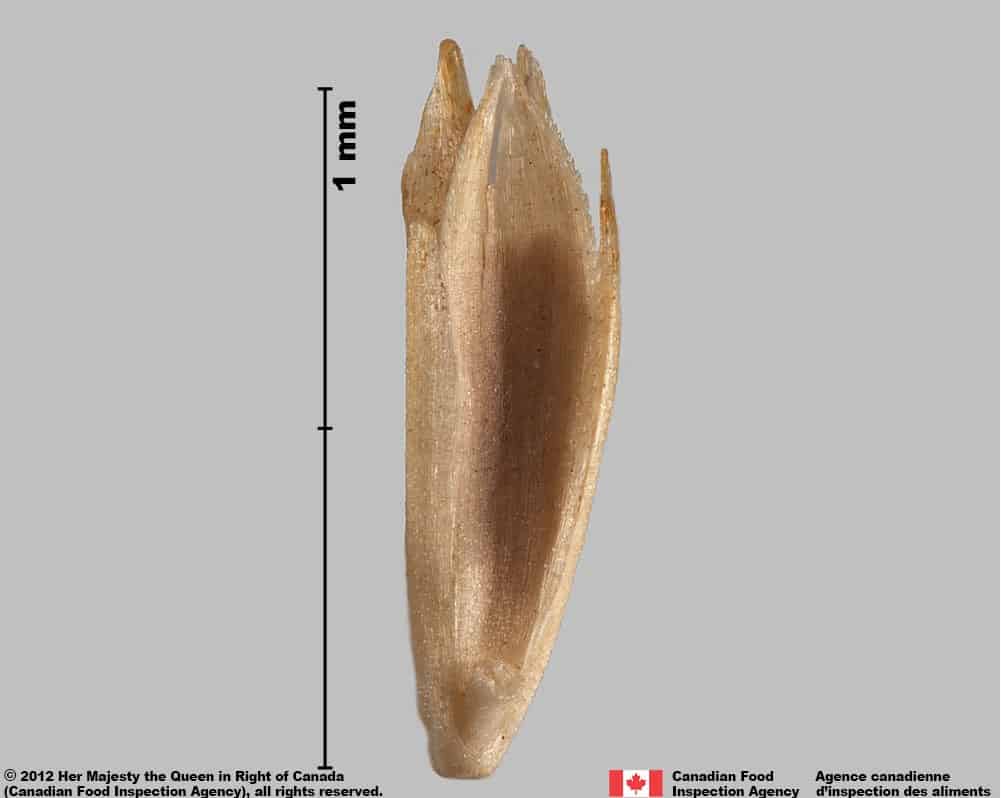
Poa compressa
Poaceae
Canada bluegrass (Poa compressa) floret, palea view
SIMILAR SPECIES
ESPÈCES SEMBLABLES
Poa compressa
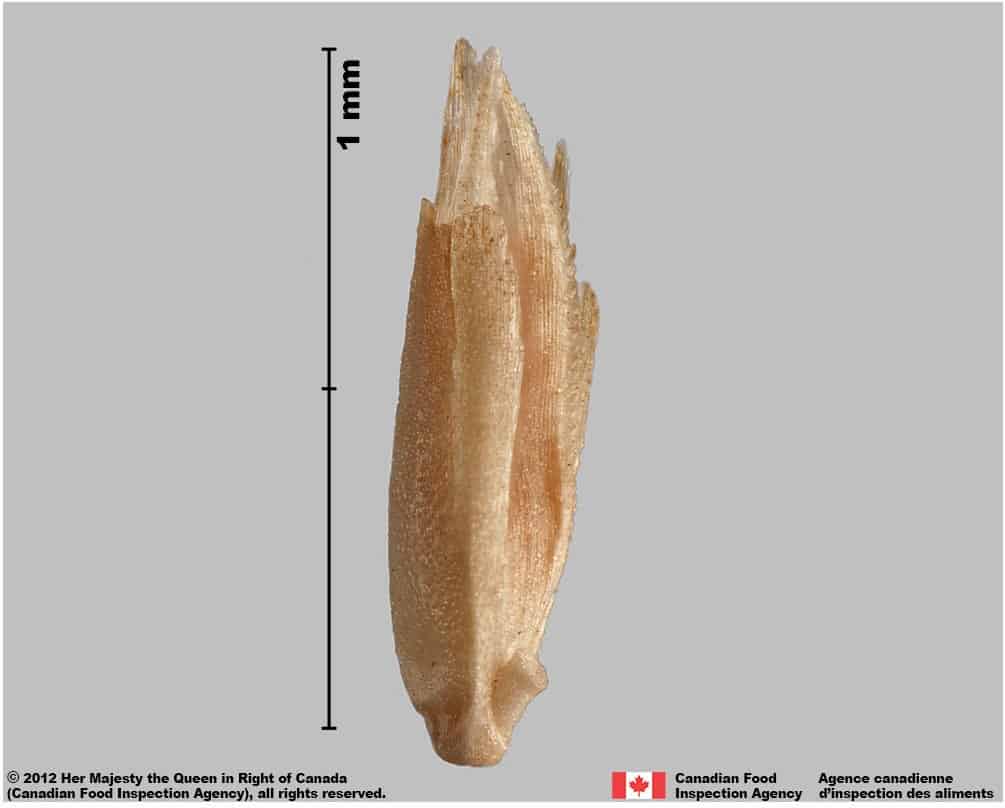
Poa compressa
Poaceae
Canada bluegrass (Poa compressa) floret, side view
SIMILAR SPECIES
ESPÈCES SEMBLABLES
Poa compressa
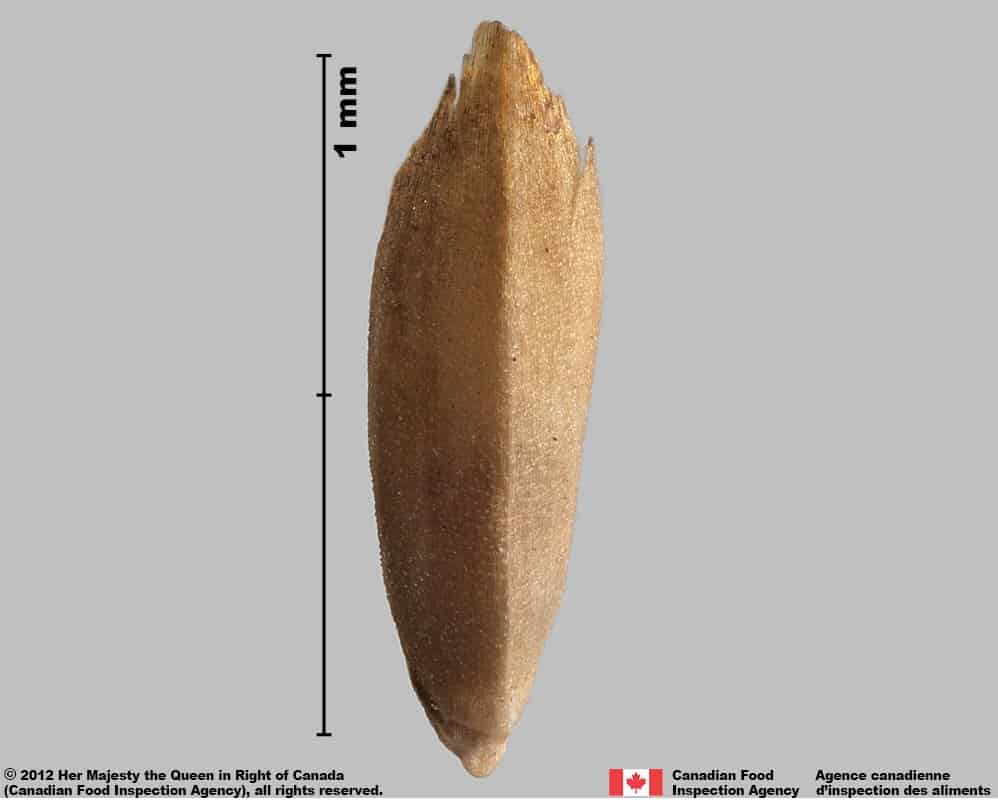
Poa compressa
Poaceae
Canada bluegrass (Poa compressa) floret, lemma view
SIMILAR SPECIES
ESPÈCES SEMBLABLES
Poa compressa
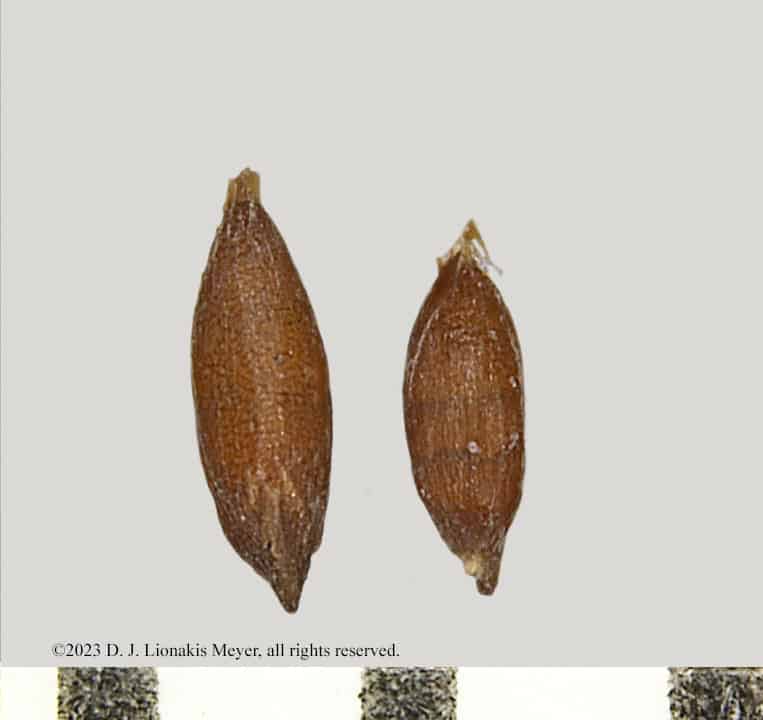
Poa compressa
Poaceae
Poa compressa caryopses, embryo view (left) and hilum view (right). Image by Deborah Meyer.
Need ID Help?
Besoin d’aide pour l’identification?
Reference(s)
Référence(s)
Alderson, J. and Sharp, W. C. 1995. Grass varieties in the United States, U.S.D.A. Agric. Handbook 170, rev. ed. CRC Press.
Association of Official Seed Analysts (AOSA). 2022. Rules for Testing Seeds, Vol. 1: Principles and Procedures. Association of Official Seed Analysts, Washington D. C.
Australian Plant Name Index (APNI). 2022. Vascular Plants, Poa pratensis. https://biodiversity.org.au/nsl/services/search/names?product=apni&name=Poa%20pratensis&inc._scientific=&inc.scientific=on&inc._cultivar=&inc._other=&max=100&display=apni&search=true Accessed December 16, 2022.
Barkworth, M. E., Capels, K. M., Long, S., and Piep, M. B. (eds.). 2007. Flora of North America Volume 24. Magnoliophyta: Commelinidae (in part): Poaceae, part 1. Oxford University Press, New York, New York.
Bojňanský, V. and Fargašová, A. 2007. Atlas of Seeds and Fruits of Central and East-European Flora: The Carpathian Mountains Region. Springer, Dordrecht, The Netherlands.
Bush, T. 2002. Kentucky bluegrass Poa pratensis L. Plant Factsheet. USDA NRCS Rose Lake Plant Materials Center, East Lansing, Michigan. https://plants.usda.gov/DocumentLibrary/factsheet/pdf/fs_popr.pdf.
California Invasive Plant Council (CAL-IPC). 2022. Poa pratensis. CAL-IPC. https://www.cal-ipc.org/plants/profile/poa-pratensis-profile/#:~:text=Poa%20pratensis%20%28Kentucky%20bluegrass%29%20is%20a%20perennial%20grass,and%20the%20species%20increases%20with%20grazing%20and%20burning. Accessed December 16, 2022.
Canadian Food Inspection Agency (CFIA). 2023. Canadian Methods and Procedures for Testing Seeds (M&P). Version 1.1, English. Canadian Food Inspection Agency.
Centre for Agriculture and Bioscience International (CABI). 2022. Poa pratensis (smooth meadow-grass) – Datasheet. CABI – Invasive Species Compendium. https://www.cabi.org/isc/datasheet/42489. Accessed December 16, 2022.
DiTomaso, J. M. and Healy, E. A. 2007. Weeds of California and Other Western States. Vol. 2: Geraniaceae – Zygophyllaceae. Agriculture and Natural Resources Publication 3488. University of California, Oakland, CA.
Douglas, G. W., Meidinger, D., and Pojar, J. (eds.). 2001. Illustrated Flora of British Columbia Vol. 7 Monocotyledons (Orchidaceae through Zosteraceae). British Columbia Ministry of Sustainable Resource Management and Ministry of Forests. p. 250. https://www.for.gov.bc.ca/hfd/pubs/docs/Mr/Mr106.pdf.
eFloras. 2022. Flora of China. Poa pratensis. efloras.org Accessed December 13, 2022.
International Seed Morphology Association (ISMA). 2020. Method for seed size measurement. Version 1.0. ISMA Publication Guide. https://www.idseed.org/authors/details/method_for_seed_size_measurement.html.
International Seed Testing Association (ISTA). 1982. A multilingual Glossary of Common Plant-Names. 1. Field crops, grasses and vegetables, Ed. 2. International Seed Testing Association.
Martin, A. C. 1946. The comparative internal morphology of seeds. The American Midland Naturalist 36(3):513-660.
Musil, A. F. 1963. Identification of Crop and Weed Seeds. Agriculture Handbook No. 219. U. S. Department of Agriculture. Washington, D.C.
Pacific Island Ecosystems at Risk (PIER). 2011. Poa pratensis L., Poaceae. http://www.hear.org/pier/species/poa_pratensis.htm. Accessed December 16, 2022.
Terrell, E. E. 1971. Survey of occurrences of liquid or soft endosperm in grass genera. Bull. Torr. Botan. Club 98(5):264-268.
United States Department of Agriculture-Agricultural Marketing Service (USDA-AMS). 2022. Federal Seed Act Regulations. https://www.ecfr.gov/current/title-7/subtitle-B/chapter-I/subchapter-K/part-201 Accessed December 16, 2022.
United States Department of Agriculture-Agricultural Research Service-National Plant Germplasm System (USDA-ARS). 2022. Germplasm Resources Information Network (GRIN Taxonomy). National Germplasm Resources Laboratory, Beltsville, Maryland. URL: https://npgsweb.ars-grin.gov/gringlobal/taxon/taxonomydetail?id=28996 Accessed December 16, 2022.
Weber, E. 2017. Poa pratensis in E. Weber (Auth.) Invasive Plant Species of the World 2nd Edition. A Reference Guide to Environmental Weeds. Wallingford, Oxfordshire; Boston, MA: CABI, 2016: pp. 368-369. https://cabidigitallibrary.org/doi/epdf/10.1079/9781780643861.0000.
Wiersema, J. H. and León, B. 1999. World Economic Plants: A Standard Reference. CRC Press, Boca Raton, FL.



